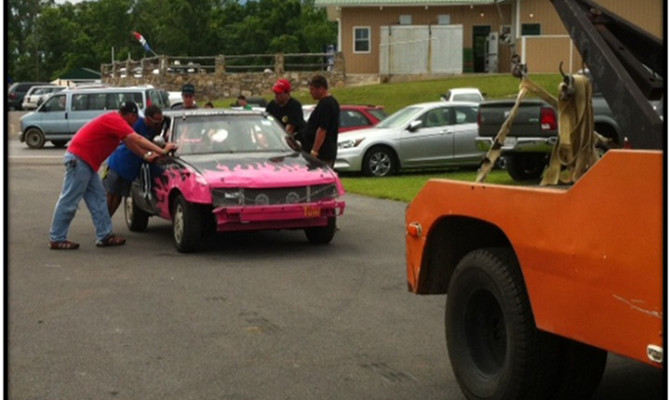“Sometimes, when you have a breakdown you’ve got to go with what falls readily to hand, whether it’s duct tape, J-B Weld or a coat hanger.”
We’re not always around a fully stocked garage, auto parts store or tool chest when the need arises to save the day with a big repair.
Sometimes, when you have a breakdown you’ve got to go with what falls readily to hand, whether it’s duct tape, J-B Weld or a coat hanger. Here are five stories of some truly epic improvised repairs:
Dormitory parking lot transmission repair: Rory Carroll is now the Executive Editor of Autoweek magazine. While at Michigan State University, he was foolish enough to loan his 1991 Volkswagen Golf GTI to a fellow student the day before he was supposed to make the three-hour drive home to Traverse City, Mich. “When he returned the keys to me, he told me that the car had made a loud noise when he’d parked it.” Carroll found the GTI in the dorm parking lot sitting in a pool of oil; the “friend,” however, was nowhere to be seen. Two chunks of transaxle case were lying in the middle of said pool. Carroll took a bus to a hardware store where he purchased some J-B Weld and, optimistically, four quarts of transaxle oil. He cleaned the pieces of the transaxle case in his dorm room sink, mixed up the J-B Weld and drove the Golf up onto the curb to get at the transaxle. Carroll pushed the metal fragments and J-B Weld back into place, wedged them in with a piece of wood and waited a few hours before refilling the transaxle with oil and hitting the road — into the jaws of a winter storm as only Northern Michigan can do them.
Blown head gasket and cylinder head during a race: The 24 Hours of LeMons is an endurance race for $500 cars. The organizers say that the premise “isn’t just an oxymoron, it’s a breeding ground for morons.” Damned resourceful morons, anyway — perhaps even the Steve Jobs and Thomas Edison of the improvised repair world. Team Dr. Feelgood’s 1993 Dodge Shadow was participating in “Capitol Offense,” the D.C.-area version of the infamous motorsports affront, when not surprisingly; the Shadow blew a head gasket and disintegrated part of the cylinder head itself. The intrepid racers made a new gasket and slathered J-B Weld on the toasted cylinder head, allowing them to finish the race and win the coveted Judge’s Choice Award without having to resort to a bribe, as is customary for awards in the LeMons world.
Leaky radiator addressed by another kind of leak: Tim Suddard is the publisher of Classic Motorsports and Grassroots Motorsports magazines. No stranger to ill-advised road trips in old cars, Suddard (who resides in Florida) was on a cross-country road trip in a vintage motor home, when it sprang a leak in its radiator while traversing sparsely populated Wyoming. He valiantly dumped every liquid in the motor home into the radiator but still fell short of the nearest town (and bathroom) by a few miles. He killed two birds with one stone, and you can guess how.
Fabricated Florida fan belt: Another time, Suddard found himself behind the wheel of a questionable machine, a dilapidated early 1990s vintage E30 BMW 318. Rather than towing the car home, he elected to drive the tired Bimmer the 200 odd miles home. Predictably, something failed (in this case, a fan belt in I-95 Miami rush hour). The ever-resourceful Suddard reached for the only thing that fell readily to hand, a roll of duct tape known to racers affectionately as “200 mph tape.” By twisting a length of it repeatedly, and then fastening the ends, Suddard was able to fashion a temporary fan belt that allowed him to make it home.
Failed generator generates repeat battery purchases: Suddard is clearly a good guy to have around when you break down in the middle of nowhere. In the third chapter of the Suddard trilogy, a few years back, he bought a 1963 Ford Ranchero. The seller assured Suddard it was ready to drive across the country. Taking him at his word, Suddard set off in the Ranchero on a cross-country drive. As it turns out, it was far from road ready with no heat and a failing generator. Given the fact that Ford had switched from alternators to generators for the 1965 model year, there were none to be found in any auto parts stores along the way. Suddard simply stocked up on batteries and a battery charger — enough batteries to power a Soviet-era diesel/electric submarine. He drove (during the daytime only) on the batteries and charged them in the hotel room at night.
Rob Sass is the vice-president of content for Hagerty Insurance. Hagerty is the world’s leading specialist provider of classic car and boat insurance. Learn more at hagerty.ca and you can email rsass [at] hagerty [dot] com
Recent Comments
- { Enjoyed your Forest of Bowland in the BMW X5M, particularly the photo of the BMW in front of the main part of Stonyhurst College where... }
- { Bantam designed the Jeep, not Willy's or Ford. The American military gave the original Bantam prototype to Willys and Ford to copy. There is plenty... }
- { All Escalades come with a 6.2-lilter V8 engine that produces 420 horsepower. A six-speed automatic is the only transmission offered and drives the rear wheels.... }
- { Alexandra is an excellent journalist. }
Popular Posts
- Journey to a ‘Sparkling’ Luxury Okanagan Resort “Four lucky readers will put a Dodge Journey’s weekend-...
- The Need For Speed: Hike Those Highway Limits More than half of those polled believe the province sho...
- Drives-U-Crazy… Erratic drivers. An early morning drive from Kelowna to Vancouver is nor...
- Readers Respond: The Pros and Cons of Increasing B.C. Speed Limits Increasing the speed limits will only increase risk to...
- Honda CR-V Review: The Compact Crossover To Get Things Done The CRV is a very stylish and aerodynamic crossover veh...







